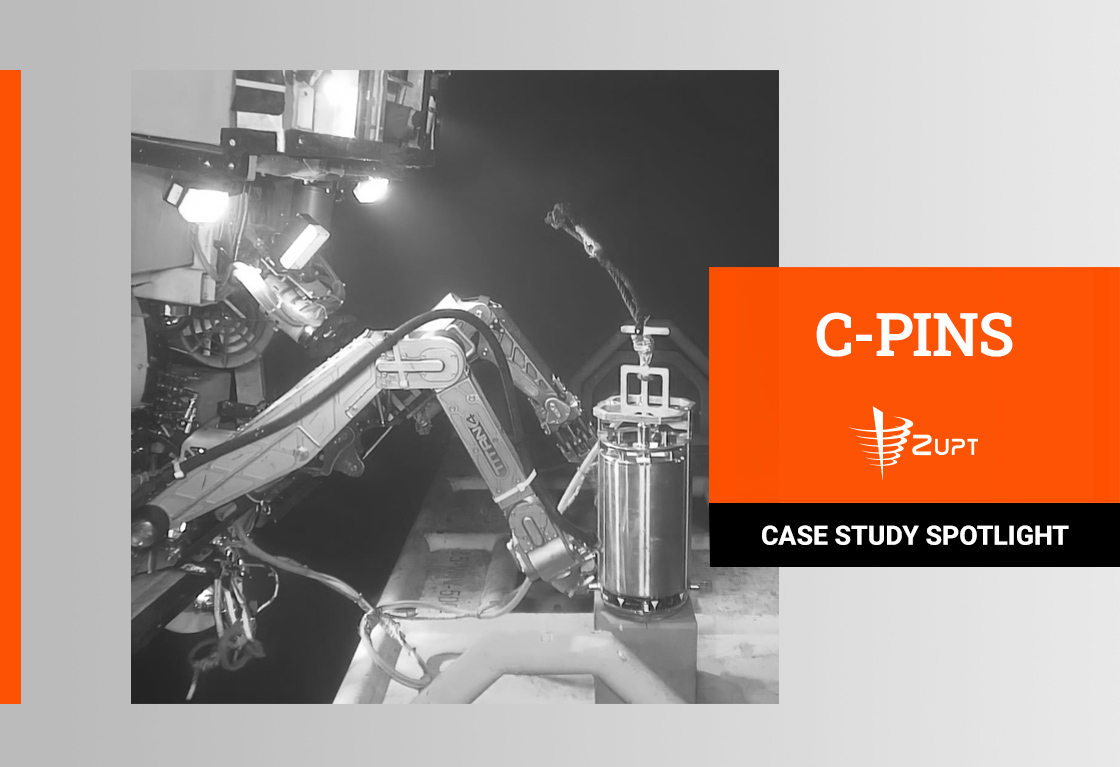Get in touch with us for any questions or quotes on surveying services and products. We will respond back as soon as we can.
Case Study Spotlight: Inertial vs. Acoustic Metrology Methodology Supported by Zupt’s Super Major Client
Introduction
This case study evaluates the deployment of Zupt, LLC's C-PINS inertial navigation technology as a replacement for conventional acoustic-based methods in subsea metrology. Conducted in partnership with Zupt's Super Major Client, the study involved extensive field trials aimed at assessing C-PINS' maturity, precision, and operational efficiency versus acoustic LBL techniques. Quantitative results confirmed the system's ability to deliver significant vessel time savings, enhanced data precision and adaptability to challenging subsea environments.
Methodology and Scope
1. Direct Line-of-Sight (Acoustic Tape Measure):
- Measurement between hubs with unobstructed acoustic paths.
- Conventional equipment: Acoustic transponders, pressure sensors, AHRS.
- Typical time: 6–7 hours.
2. Braced Quadrilateral Techniques:
- Deployment of additional acoustic transponders to form a minimal LBL array.
- Over-determined solutions for enhanced accuracy.
- Typical time: 10–12 hours.
3. Full LBL Array (Non-Line-of-Sight between hubs):
- Deployment of multi-beacon arrays for complex field layouts where direct acoustic paths are unavailable between the two hubs.
- Typical time: 24+ hours.
The C-PINS inertial navigation system, which integrates navigation-grade IMUs, "zupt" algorithms, and proprietary data processing, was deployed in parallel. The system measured horizontal distances, depth offsets, and attitudes (pitch, roll, and heading) between hubs. All deliverables were generated onboard.
Quantitative Findings
- C-PINS demonstrated exceptional time savings, particularly in non-line-of-sight configurations:
| Technique | Acoustic Time | C-PINS Time |
Time Savings |
| Direct Line-of-Sight | 6–7 hours | 6-7 hours | Parity |
| Braced Quadrilateral | 10–12 hours | 6-7 hours | 40–50% reduction |
| Full LBL Array | 24+ hours | 6-7 hours | 70+% reduction |
- Early inertial metrology deployments required ~10–12 hours, but procedural optimizations reduced total survey time to 5–7 hours.
- Single-dive operations eliminated the need for repeated ROV trips, significantly enhancing efficiency.
3. Data Quality:
- Horizontal distance discrepancies averaged 26–70 mm, within client specifications.
- Attitude (pitch and roll) data differences were consistently <0.2°, and heading deviations averaged ~0.3°.
- Real-time quality control metrics, including loop closures and drift thresholds, ensured reliable data acquisition.
4. Noise Resilience:
- Inertial systems were unaffected by acoustic interference from drilling activities, enabling uninterrupted operations.
- Motion noise during drilling was reduced by ~35% compared to idle conditions, demonstrating the system's robustness in dynamic environments.
5. Environmental Benefits:
- Simplified equipment requirements reduced the overall offshore footprint.
- The inertial system required a single RS232 interface to the ROV minimizing cabling complexity, further enhancing operational efficiency.
Technical Innovations
- The C-PINS system constrained IMU drift through zupt corrections, ensuring precision over extended operations.
- Drift thresholds were calibrated to tolerate minor ROV-induced vibrations without compromising data quality.
2. Real-Time Data Processing:
- Surface software (SSTT) provided real-time QC, including drift metrics, loop miss-closures, and redundant data overlays.
- Onboard deliverables included the required metrology deliverable: pitch/roll data, horizontal/vertical hub to hub distances and bathymetry.
3. Improved Tooling:
- Enhanced rotating stabs reduced noise in heading measurements and minimized ROV manipulation requirements, hence time.
- Compact sensor integration allowed simultaneous collection of bathymetry and inertial data in a single dive.
The table below summarizes the differences between conventional and inertial methods:
Comparison of Techniques
| Parameter | Acoustic (LBL) | C-PINS (Inertial) |
| Horizontal Distance Accuracy |
<50 mm | 26–70 mm |
| Attitude Accuracy (Pitch/Roll) | 0.5°–1.0° | <0.2° |
| Time per Survey | 24+ hours | 6 hours |
| Equipment Footprint | Large transponder array | Compact (single unit) |
| Noise Susceptibility | Affected by acoustics | Resilient to noise |
| Line of sight | All transponders need to see each other | Not required |
| Interfaces to ROV | Acoustic transceiver, AHRS, Depth transducer minimum | Single interface to ROV |
Industry Implications
- Efficiency Gains: Reducing survey time by over 50%, resulting in fewer vessel days to complete the same operations lowering costs.
- Data Integrity: Enhanced accuracy and real-time QC improved confidence in deliverables.
- Operational Versatility: Reliable performance in acoustically noisy and constrained environments expanded deployment scenarios.
Challenges and Future Developments
- Training: Field personnel require targeted training to fully utilize inertial systems.
- Tooling Enhancements: Further refinements to stabs and ROV brackets will optimize deployment.
- Standardization: Advocacy for inertial methods within industry standards will accelerate acceptance.
Conclusion
Zupt, LLC's C-PINS technology has validated inertial metrology as a mature and highly efficient alternative to conventional acoustic systems. C-PINS has achieved a 50% reduction in vessel time, delivering precise results, and operating effectively in challenging environments, C-PINS sets a new standard for subsea metrology. Its technical innovations and robust performance make it a pivotal tool for the future of offshore construction and inspection.

